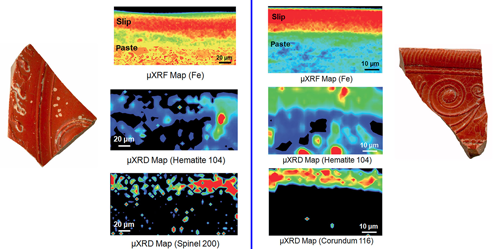Terra sigillata ceramics were the most famous ancient tableware produced during the Roman period owing to the mass production of standardized shapes and the widespread distribution of the vessels. The beautiful ceramics were characterized by their reddish coloration, glossy coating, and the unique ornamentation created by the use of stamps (sigilla). The manufacturing of the pottery originally started in central Italy during the latter half of the first century BCE, and the success of these ceramics led to the rapid spreading of the technique outside the peninsula. From the beginning of the first century CE, large production centers were set up in southern Gaul in such sites as La Graufesenque.
A team of scientists from France has investigated a large number of terra sigillata samples using both laboratory techniques and ALS Beamline 12.3.2 and found significant differences in mineral compositions between the Italic and Gallic samples—a finding that suggests modifications in the manufacturing process. Results indicate that the transfer of the production to Gaul was associated with an increase in firing temperature (from 950–1000°C to 1030–1070°C) leading to an enhanced mechanical resistance of the coating. The increased durability of the coating provided a good response to a growing need for more utilitarian vessels in the first century CE. Even though researchers were unable to directly pinpoint this evolution to a change in status of the sigillata, it is clear that this evolution in the fabrication process parallels changes in the political and economic landscape surrounding both the Italic and south-Gallic workshops during the expansion of the Roman Empire.
Studying ancient ceramics using materials science approach help reveal subtle changes in technology and provide invaluable clues for reconstructing the everyday life of past societies.

Work performed on ALS Beamline 12.3.2.
Leon, Y., Sciau, P., Passelac, M., Sanchez, C., Sablayrolles, R., Goudeau, P., & Tamura, N. “Evolution of terra sigillata technology from Italy to Gaul through a multi-technique approach,” Journal of Analytical Atomic Spectrometry, 30, 658-665 (2015).